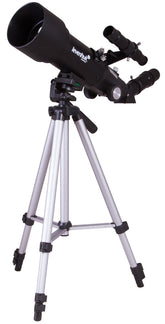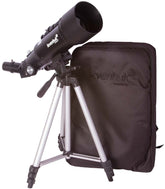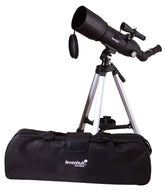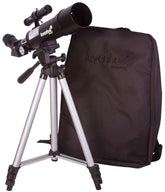Stargazing - Light Pollution and how to manage it.
If you’re interested in stargazing, it might be a barrier, or at least difficult to access areas of Madeira with low levels of light pollution to give you the best chance of getting a great view of the night sky. We know it’s not easy to observe our galaxy from the middle of a city, but it is possible.
You don’t need to travel to the top of Pico do Arieiro or out to Ponta de São Lourenço to get a great view of the moon, International Space Station, or Jupiter. With a little planning, you can catch a glimpse of these amazing sights from home (or nearby).
Usually, light pollution from densely populated areas can be prohibitive, but depending on weather conditions and your ability to find a good spot, you can be surprised with the results. General advice is to get as high above surrounding buildings as possible and try to minimise as much of the light surrounding you as possible.
If you are just beginning your Stargazing hobby, you can try several experiments which won’t cost you a fortune. A telescope is useful and will give you the best results, but you don’t need to rush out and buy an expensive piece of kit straight away.
It’s usually very easy to study the Moon, Saturn, and some of the moons of Jupiter using a pair of binoculars. It’s important that you have a clear line of sight and avoid trees and buildings that may block your view.
Why is Light Pollution a problem for Stargazers and Astronomers?
Light pollution is unwanted light that projects up into the night sky. It makes the earth’s atmosphere brighter above the source and drowns out the light from faint objects like galaxies and nebulae. This usually results from streetlights in towns and cities that are poorly designed and inefficient. These light fixtures scatter light above the horizontal plane and significantly impact astronomy.
Light pollution can also be amplified by air pollution. Dust, smoke, and emissions from vehicles and industry contribute to the scattering of sky-bound radiation, further brightening our sky.
Astronomers and Star Gazers can avoid light pollution by travelling to areas with dark skies, far from town and city locations which are the source of most light and air pollution.
How can I find the right spot?
Before you begin, you need to plan your night in advance. This will give you the best possibility of success. Do some research and make note of areas in your surroundings that can offer the best opportunity. If you’re in a built-up area, like Funchal, Santa Cruz, or Calheta, then look for some accessible areas above buildings. The trick is to find the biggest bit of sky you can or get up as high as you can. A loft window, a rooftop, the windows of upper-storey flats or a local park (especially on the outskirts of a town or city) can work well as vantage points.
The weather, and the time of year, play a big part in visibility above built-up areas. In summer, towns, and cities store heat during the day, which is released after sunset. This causes haze and humidity which can interfere with your observations.
Before you go, choose a cool and cloudless evening. Stargazing with a full moon can be extremely enjoyable, but for observations in other parts of the sky, a moonless night will offer a better experience. Winter evenings tend to be better than summer, as less night-time haze is created.
Wherever you choose your location, make sure you wrap up warm and stay safe.
You could also take a camera and read our guide to photographing the night sky before you go.
Avoid light pollution
When stargazing, it’s important to allow your eyes to adapt to the available light, a town or city’s artificial light can make this difficult, which is why we recommend getting as far away, or as high above these light sources as possible. Light pollution isn’t always the orange glow created by an urban area, it can also be a nearby streetlight or the screen of your smartphone. So be aware of all the light sources around you and do your best to minimise their impact on your observations.
If you can't turn off your smartphone, try downloading or enabling a red-light filter (or night shift), which will let you see your screen without forcing your eyes to keep readjusting to the dark.
iOS accessibility settings let you turn on colour tints on your phone, or you could even stretch old-fashioned red cellophane across the screen.
After the “Set-Up”
Once you have found your location, determined the weather conditions are favourable and set up your equipment, give yourself 15 minutes for your eyes to adjust to the dark. Keep your smartphone in your pocket and avoid using torches or fires. Be patient, it will certainly pay off.
How do you know what to look for?
Throughout the lunar calendar, the moon is easy to spot. You can always look online to see the current moon cycle or find out when the next meteor shower is forecast.
When it comes to Star Gazing, the opportunities are endless. There are billions and billions of stars out there in space, and you can see them with the naked eye, just by looking up on a clear night. You can observe them at your leisure or download a smartphone companion app that can tell you exactly what you are looking at.
We recommend something like SkyView, Sky Guide, or Night Sky. These are all free Android and iOS applications which feature a tonne of functionality. Just point your smartphone in the direction of your observation and click on the stars or constellations to find out all about them.
You can also use NASA’s website to track the position of the International Space Station, which is one of the brightest objects in our night sky.
The 88 named constellations are constantly moving across the sky, and each is visible at different times of the year. What you will be able to see will vary according to your country and the time of year, so it pays to research ahead of time.
If you are really interested in capturing shooting stars, you can install a special CCTV camera outside your home to record the night sky. There is also a resource of fixed cameras around the world that record the night sky, so check out NASA’s All Sky programme to see live footage of our night sky and solar system.
You could start your own meteor video detection camera anywhere in Europe. Setting up your own camera costs between €500 and €800, but there are other ways to catch a glimpse of extra-terrestrial magic.
Ideas for beginner and budding astronomers in Madeira
In Funchal, set yourself up in Santa Caterina Park. Sometimes the park may be closed to visitors at night, so be aware of this and check in advance. You can also set up next to the small chapel, Capela de Santa Caterina.
Ponta Garajau, at the Christo Rei statue, is close to populated areas and accessible all hours of the day. Be careful visiting these areas at night and take a headlamp or torch to illuminate the footpath ahead of you.
Above Santa Luzia, Miradouro dos Marmeleiros is a viewpoint on the road leading to Monte Palace Gardens. Here, high above Funchal you will have an unobstructed view of the night sky and be above most of the light pollution. There are still streetlights in the surrounding area. We also recommend this as a great spot to watch the firework display on New Year’s Eve.
To the west of Funchal, you can explore Pico da Cruz. This road leads from Sao Martinho above Adjuda and offers south-facing views over the ocean. A great spot, only five minutes by car from central Funchal which can offer you peace and quiet and an escape from the city’s light pollution.
How can I begin Star Gazing and Observing the Night Sky?
As we mentioned earlier, a set of Binoculars is sometimes all you need to observe the Moon and some of the planets in our Galaxy. If you want to upgrade your equipment and invest in a telescope, then visit Madeira’s only store dedicated to supplying the best optical equipment, including Telescopes, Monoculars, Binoculars, Microscopes and Spotting scopes.
Madeira Optics, Zoom’n’Joy is located in central Funchal, Rua das Pretas N-88, Loja N-1, 9000-049. We stock a wide range of telescopes from brands like Levenhuk, Bresser, Discover and National Geographic. Instruments available are suitable for beginners and experienced astronomers.
Find us online and order from www.madeiraoptics.com and view our full range of optical instruments and accessories.












